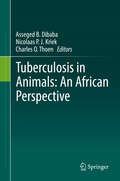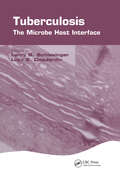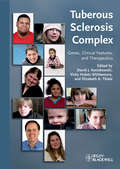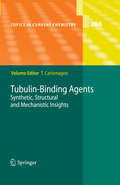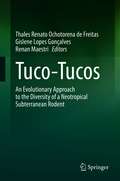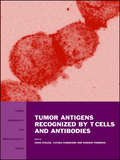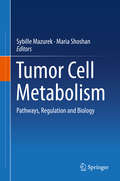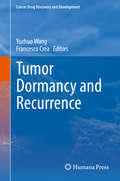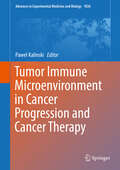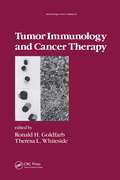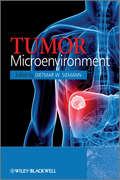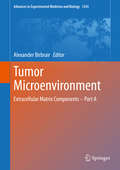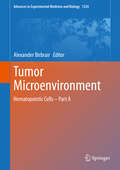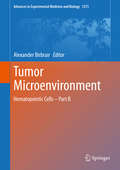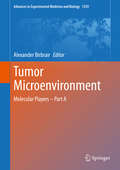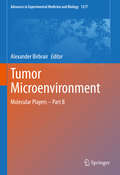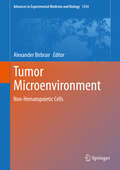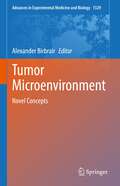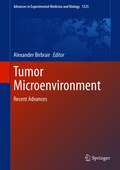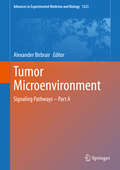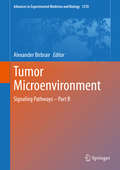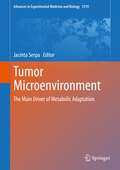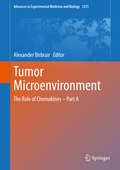- Table View
- List View
Tuberculosis in Animals: An African Perspective
by Charles O. Thoen Asseged B. Dibaba Nicolaas P. J. KriekThis book recounts the biology of M. bovis, followed by the status of bovine Tuberculosis (bTB) in African countries, primarily based on zoonotic and epidemiological field reports. Since the accumulation of data is valueless unless it led to practicable control measures, emphasis is put on locally adapted protocols for future control of the disease. In order to systematically evaluate the knowledge base of bTB, Epidemiologic Problem Oriented Approach (EPOA) methodology was used. The methodology is composed of two triads: i) the problem identification/characterization triad, which is mainly descriptive in nature, and ii) the problem management/solution/mitigation triad, which is mainly geared toward problem management/solution (see figure). The first triad comprises three pillars: i) agent ii) host, and iii) environment and the second one: i) therapeutics/treatment, ii) prevention/control, and iii) health maintenance/promotion. The two triads are linked together by the diagnostic procedure linkage. The systematic and detailed studies of the ‘Host-Agent-Environment’ interactions are the building blocks to the understanding of agent transmission pathways and disease spread. These may include data about the disease status of the country, the nature of the disease agent and its hosts, the modes of transmission, the wildlife reservoirs in nature, persistence of infection, and agent survival in animal products and the environment. The problem identification and characterization triad identifies these interactions. Once a problem has been identified and well understood, the next step is to minimize the risk of transmission and spread of a disease. This area, referred to as problem solution/management triad, consists of problem management alternatives that rely upon prevention/control, and health maintenance/promotion of the disease in livestock, wildlife, and humans with the emphasis on resource-poor, developing countries in Africa.
Tuberculosis: The Microbe Host Interface
by Larry S. Schlesinger Lucy E. DesJardinM. tuberculosis remains one of the most successful human pathogens known. The causative agent of tuberculosis, it also has a unique ability to persist for years in the infected, apparently healthy host. This dormant organism can be reactivated years, even decades later to cause tuberculosis. This book reviews the most important state-of-the-art approaches currently used to study microbe-host interactions and highlights emerging methodologies.
Tuberous Sclerosis Complex: Genes, Clinical Features and Therapeutics (Developmental Perspectives In Psychiatry Ser.)
by Elizabeth A. Thiele David J. Kwiatkowski Vicky Holets WhittemoreThe only comprehensive overview of the molecular basis and clinical features of the genetic disorder tuberous sclerosis, which affects approximately 50,000 people in the US alone. Special focus is placed on novel insights into the signal transduction pathways affected by the disease as well as genotype phenotype correlations, while existing and potential therapies are also discussed in depth. The editors are leading experts in research and treatment of the disease as well as the Vice President of the Tuberous Sclerosis Alliance, the only voluntary health organization for TSC in the US.
Tubulin-Binding Agents
by Teresa CarlomagnoThis series presents critical reviews of the present position and future trends in modern chemical research. It contains short and concise reports on chemistry, each written by the world renowned experts.
Tuco-Tucos: An Evolutionary Approach to the Diversity of a Neotropical Subterranean Rodent
by Thales Renato Ochotorena de Freitas Gislene Lopes Gonçalves Renan MaestriThis book examines the biology of tuco-tucos (Ctenomys) from an evolutionary perspective. Historically, these subterranean rodents have long attracted the attention of scientists due to its remarkable chromosomes variability and rapid diversification. A wealth of knowledge on physiology, ecology, genetics, morphology, paleontology, and taxonomy has been documented in the last 70 years through numerous single publications. In this volume, expert investigators review and frame these essays with the breadth of current understanding. The collection of chapters are presented into the major topics: i) Evolution of Ctenomys, ii) Geographic Patterns, iii) Organismal Biology, and iv) Environmental Relationships. Given its scope, the book will be of interest to both students and researchers and may stimulate further research with this exciting model on a wide range of evolutionary topics.
Tumble
by Adriana Hernández BergstromThis gorgeous, poetic story follows the unexpected journey of a lone tumbleweed making its way across the desert. <P><P> Wind blows.<br> Tumble goes.<br> Fence stops.<br> Tumble hops.<br> Cactus waves.<br> Tumble stays, and stays, and stays. <P><P> Using simple, succinct text and richly colored art, Adriana Hernández Bergstrom follows one tumbleweed on its journey across a desert unexpectedly teeming with life. <P><P> Tumble is an incredible read-aloud perfect for storytime or newly independent readers. Extensive backmatter identifies every plant and animal featured in the book and provides more information on the misunderstood tumbleweed and its ecosystem. <P><P><i>Advisory: Bookshare has learned that this book offers only partial accessibility. We have kept it in the collection because it is useful for some of our members. Benetech is actively working on projects to improve accessibility issues such as these.</i>
Tumblr®: How David Karp Changed the Way We Blog
by Aurelia JacksonIn the last few years, Tumblr has become one of the most popular social networking websites. Before Tumblr was the company we know today, however, it was just one of David Karp's smaller projects. Learn more about one of the most successful young people working in tech--and how he changed the way people share who they are and what they like. Discover the story behind David Karp's success--and find out what it takes to turn a new company into something amazing.
Tumor Antigens Recognized by T Cells and Antibodies (Tumor Immunology Ser.)
by Hans J. Stauss Yutaka Kawakami Giorgio ParmianiRecent progress in fundamental tumor immunology has led to immunotherapy trials in patients with solid tumors and hematological malignancies. In the past, immunotherapy approaches were primarily based on enhancement of tumor immunity with cytokines and adjuvant therapy, without knowledge of relevant tumor antigens. The discovery of tumor antigens c
Tumor Cell Metabolism
by Sybille Mazurek Maria ShoshanThe four sections of this book cover cell and molecular biology of tumor metabolism, metabolites, tumor microenvironment, diagnostics and epigenetics. Written by international experts, it provides a thorough insight into and understanding of tumor cell metabolism and its role in tumor biology. The book is intended for scientists in cancer cell and molecular biology, scientists in drug and diagnostic development, as well as for clinicians and oncologists.
Tumor Dormancy and Recurrence
by Yuzhuo Wang Francesco CreaThis volume will be the first to provide a comprehensive description of tumor dormancy. It will define the clinical and biological aspects of this phenomenon, as well as the cellular and molecular mechanisms associated with tumor dormancy. Chapters will be authored by world-renewed experts who are conducting cutting-edge research in the field. A unique feature will be a conclusive paragraph detailing future development and foreseeable clinical applications at the end of each chapter. The volume will serve as a fundamental instrument for every researcher and clinician interested in the field of tumor dormancy as well as a means of disseminating stimulating concepts and prompting the development of innovative technological solutions.
Tumor Immune Microenvironment in Cancer Progression and Cancer Therapy (Advances in Experimental Medicine and Biology #1036)
by Pawel KalinskiThe tumor microenvironment has become a very important and hot topic in cancer research within the past few years. The tumor microenvironment is defined as the normal cells, molecules, and blood vessels that surround and feed a tumor cell. As many scientists have realized, studying the tumor microenvironment has become critical to moving the field forward, since there are many players in a tumor’s localized and surrounding area, which can significantly change cancer cell behavior. There is a dual relationship wherein the tumor can change its microenvironment and the microenvironment can affect how a tumor grows and spreads. Tumor Microenvironment in Cancer Progression and Cancer Therapy aims to shed light on the mechanisms, factors, and mediators that are involved in the cancer cell environment. Recent studies have demonstrated that in addition to promoting tumor progression and protecting tumor cells from the spontaneous immune-mediated rejection and different forms of cancer therapeutics, tumor microenvironment can also be a target and mediator of both standard and newly-emerging forms of cancer therapeutics. Thus, the dual role of the tumor microenvironment is the integral focus of the volume. The volume highlights the bi-directional interactions between tumor cells and non-malignant tumor component during tumor progression and treatment. It also focuses on the three groups of the reactive tumor component: stromal cells, blood vessels and the infiltrating immune cells. These three groups are discussed under the lens of their role in promoting tumor growth, shielding the tumor from rejection and from standard forms of cancer therapies. They are emerging as targets and mediators of standard and new forms of potential therapy.
Tumor Immunology and Cancer Therapy
by R. H. GoldfarbBased on a Tumor Immunology Symposium held in Pittsburgh, this work provides comprehensive coverage of the most important aspects of tumor immunology. It reveals novel approaches to the immunotherapy of cancer and presents complex issues in an accessible manner.
Tumor Microenvironment
by Dietmar W. SiemannThe microenvironment in which a tumor originates plays a critical role in its initiation and progression. Tumor Microenvironment reviews the importance of tumor microenvironment in cancer management. Particular emphasis is placed on discussing how the unique characteristics of the tumor microenvironment not only impact disease progression and response to conventional anticancer therapies, but have also led to the identification of potential new therapeutic targets and treatment possibilities for cancer patients. Tumor Microenvironment also reviews the fundamental basis of target development, preclinical assessment, and the current clinical status of these therapies.
Tumor Microenvironment: Extracellular Matrix Components – Part A (Advances in Experimental Medicine and Biology #1245)
by Alexander BirbrairRevealing essential roles of the tumor microenvironment in cancer progression, this volume focuses on the extracellular matrix components of the tumor during cancer development. Further, it teaches readers about the roles of distinct constituents of the tumor microenvironment and how they affect cancer development. Topics include heparan sulphate, hyaluronan, fibronectin, perlecan, glypican, matrix metalloproteinases, and much more. Taken alongside its companion volumes, Tumor Microenvironment: Extracellular Matrix Components – Part A updates us on what we know about the different aspects of the tumor microenvironment, as well as apprises us on the future advances in the field. For the newest generation of researchers, this volume serves as a useful introduction to the history of scientists’ focus on the tumor microenvironment, and explores how this knowledge is currently applied in cancer treatments. The book is an essential text for advanced cell biology and cancer biology students, as well as for scientists seeking an update on the developments in tumor microenvironment research.All of the chapter authors are renowned international experts in the field of cancer biology, and in the specific subfields that are the focus of their chapters.
Tumor Microenvironment: Hematopoietic Cells – Part A (Advances in Experimental Medicine and Biology #1224)
by Alexander BirbrairRevealing essential roles of the tumor microenvironment in cancer progression, this book focuses on the role of hematopoietic components of the tumor microenvironment. Further, it teaches readers about the roles of distinct constituents of the tumor microenvironment and how they affect cancer development. Topics include neutrophils, basophils, T helper cells, cytotoxic lymphocytes, fibrocytes, and myeloid-derived suppressor cells, and more.Taken alongside its companion volumes, these books update us on what we know about various aspects of the tumor microenvironment as well as future directions. Tumor Microenvironment: Hematopoietic Cells – Part A is essential reading for advanced cell biology and cancer biology students as well as researchers seeking an update on research in the tumor microenvironment.
Tumor Microenvironment: Hematopoietic Cells – Part B (Advances in Experimental Medicine and Biology #1273)
by Alexander BirbrairRevealing essential roles of the tumor microenvironment in cancer progression, this book focuses on the role of hematopoietic components of the tumor microenvironment. Further, it teaches readers about the roles of distinct constituents of the tumor microenvironment and how they affect cancer development. Topics include eosinophils, NK cells, γδ T cells, regulatory T Cells, Langerhans cells, hematopoietic stem cells, Mast cells, B cells and Microglia, and more. Taken alongside its companion volumes, Tumor Microenvironment: Hematopoietic Cells – Part B updates us on what we know about various aspects of the tumor microenvironment as well as future directions. This book is essential reading for advanced cell biology and cancer biology students as well as researchers seeking an update on research in the tumor microenvironment.
Tumor Microenvironment: Molecular Players – Part A (Advances in Experimental Medicine and Biology #1259)
by Alexander BirbrairThis book provides a comprehensive overview of the latest research on the molecular players in the tumor microenvironment, including Cathepsin D, galectins, iron, oxygen, Phospholipase D1, leptin, extracellular vesicles, and more. Taken alongside its companion volumes, these books update us on what we know about the tumor microenvironment as well as future directions. Tumor Microenvironment: Molecular Players – Part A is essential reading for advanced cell biology and cancer biology students as well as researchers seeking an update on research in the tumor microenvironment.
Tumor Microenvironment: Molecular Players – Part B (Advances in Experimental Medicine and Biology #1277)
by Alexander BirbrairThis book provides a comprehensive overview of the latest research on the molecular players in the tumor microenvironment, including MicroRNAs, estrogen, Caveolin-1, Nitric Oxide, RANK/RANKL signaling, , COX-2 Signaling, Renin–angiotensin system, and more. Taken alongside its companion volumes, Tumor Microenvironment: Molecular Players – Part B updates us on what we know about the tumor microenvironment, as well as future directions. This book is essential reading for advanced cell biology and cancer biology students as well as researchers seeking an update on research in the tumor microenvironment.
Tumor Microenvironment: Non-Hematopoietic Cells (Advances in Experimental Medicine and Biology #1234)
by Alexander BirbrairRevealing essential roles of the tumor microenvironment in cancer progression, this volume focuses on non-hematopoietic cells within the tumor microenvironment.Further, it teaches readers about the roles of distinct constituents of the tumor microenvironment and how they affect cancer development. Topics include fibroblasts, adipocytes, mesenchymal stem cells, stellate cells, and more. Taken alongside its companion volumes, Tumor Microenvironment: Non-Hematopoietic Cells updates us on what we know about the different aspects of the tumor microenvironment as well as future directions. Useful for introducing the newer generation of researchers to the history of how scientists focused in the tumor microenvironment and how this knowledge is currently applied for cancer treatments, it will be essential reading for advanced cell biology and cancer biology students as well as researchers seeking an update on research in the tumor microenvironment.All of the chapter authors are renowned international experts in the cancer biology field in specific subfields that will be the focus of their chapters.
Tumor Microenvironment: Novel Concepts (Advances in Experimental Medicine and Biology #1329)
by Alexander BirbrairThis volume discusses novel concepts in cancer biology, focusing on different factors that affect the tumor microenvironment. Topics covered include sex-based differences in the tumor microenironment, dormancy in the tumor microenvironment, the influence of obesity on the tumor microenvironment, and much more. Taken alongside its companion volumes, Tumor Microenvironment: Novel Concepts covers the latest research on various aspects of the tumor microenvironment, as well as future directions. Useful for introducing the newer generation of researchers to the history of how scientists studied the tumor microenvironment as well as how this knowledge is currently applied for cancer treatments, it will be essential reading for advanced cell biology and cancer biology students, as well as researchers seeking an update on research on the tumor microenvironment.
Tumor Microenvironment: Recent Advances (Advances in Experimental Medicine and Biology #1225)
by Alexander BirbrairThis volume discusses recent research advances in cancer biology, focusing on the role of the tumor microenvironment. Taken alongside its companion volumes, Tumor Microenvironment: Recent Advances covers the latest research on various aspects of the tumor microenvironment, as well as future directions. Useful for introducing the newer generation of researchers to the history of how scientists studied the tumor microenvironment as well as how this knowledge is currently applied for cancer treatments, it will be essential reading for advanced cell biology and cancer biology students, as well as researchers seeking an update on research on the tumor microenvironment.
Tumor Microenvironment: Signaling Pathways – Part A (Advances in Experimental Medicine and Biology #1223)
by Alexander BirbrairRevealing essential roles of the tumor microenvironment in cancer progression, this book provides a comprehensive overview of the latest research on how different signaling pathways are important in the tumor microenvironment. Multiple signaling pathways are covered, including S1P, neuregulin, Notch, erythropoietin, Rho-ROCK, mTOR, and more.Taken alongside its companion volumes, these books update us on what we know about various aspects of the tumor microenvironment as well as future directions. Tumor Microenvironment: Signaling Pathways – Part A is essential reading for advanced cell biology and cancer biology students as well as researchers seeking an update on research in the tumor microenvironment.
Tumor Microenvironment: Signaling Pathways – Part B (Advances in Experimental Medicine and Biology #1270)
by Alexander BirbrairRevealing essential roles of the tumor microenvironment in cancer progression, this book provides a comprehensive overview of the latest research on how different signaling pathways are important in the tumor microenvironment. Multiple signaling pathways are covered, including Src, Neuregulin, Adenosine, TGFβ, Androgen, Wnt, and more.Taken alongside its companion volumes, these books update us on what we know about various aspects of the tumor microenvironment as well as future directions. Tumor Microenvironment: Signaling Pathways – Part B is essential reading for advanced cell biology and cancer biology students as well as researchers seeking an update on research in the tumor microenvironment.
Tumor Microenvironment: The Main Driver of Metabolic Adaptation (Advances in Experimental Medicine and Biology #1219)
by Jacinta SerpaThe way a cell undergoes malignant transformation should meet their capacity of surviving in the microenvironment of the organ where the cancer will develop. Metabolic adaptation is for sure one of the criteria that must be accomplished, driven by metabolic plasticity that allows the adaptation of cancer cells to the availability of energy and biomass sources that will sustain cell survival and proliferation. Each human organ has a particular microenvironment which depends on several cell types and in some cases also on symbiotic microorganisms. These biological partners are constantly sharing organic compounds and signaling molecules that will control mitogenesis, cell death and differentiation, accounting for the organ's function. Nevertheless, cancer cells are capable of taking advantage of this metabolic and signaling microenvironmental dynamics.In this book, we intend to present the different components of the microenvironment driving the metabolic fitness of cancer cells. The metabolic changes required for establishing a tumor in a given microenvironment and how these metabolic changes limit the response to drugs will generally be the major items addressed. It is important to mention not only aspects of the microenvironment that stimulate metabolic changes and that select better adapted tumor cells, but also how this regulation of cell plasticity is made. Thus, the signaling pathways that orchestrate and are orchestrated throughout this panoply of metabolic rearrangements will also be addressed in this book. The subjects will be presented from the conceptual point of view of the cross-cancer mechanisms and also particularizing some models that can be examples and enlightening within the different areas.
Tumor Microenvironment: The Role of Chemokines – Part A (Advances in Experimental Medicine and Biology #1231)
by Alexander BirbrairRevealing essential roles of the tumor microenvironment in cancer progression, this book provides a comprehensive overview of the latest research on the role of chemokines in the tumor microenvironment. Each chapter focuses on the chemokines patterns of expression, their regulation, and their roles in immune cell recruitment, as well as how they affect cancer immunity and tumorigenesis. Taken alongside its companion volumes, Tumor Microenvironment: The Role of Chemokines – Part A updates us on what we know about various aspects of the tumor microenvironment as well as future directions. This book is essential reading for advanced cell biology and cancer biology students as well as researchers seeking a comprehensive update on research in the tumor microenvironment.
